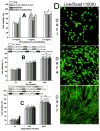Click chemistry improved wet adhesion strength of mussel-inspired citrate-based antimicrobial bioadhesives
- PMID: 27770631
- PMCID: PMC5121090
- DOI: 10.1016/j.biomaterials.2016.10.010
Click chemistry improved wet adhesion strength of mussel-inspired citrate-based antimicrobial bioadhesives
Abstract
For the first time, a convenient copper-catalyzed azide-alkyne cycloaddition (CuAAC, click chemistry) was successfully introduced into injectable citrate-based mussel-inspired bioadhesives (iCMBAs, iCs) to improve both cohesive and wet adhesive strengths and elongate the degradation time, providing numerous advantages in surgical applications. The major challenge in developing such adhesives was the mutual inhibition effect between the oxidant used for crosslinking catechol groups and the Cu(II) reductant used for CuAAC, which was successfully minimized by adding a biocompatible buffering agent typically used in cell culture, 4-(2-hydroxyethyl)-1-piperazineethanesulfonic acid (HEPES), as a copper chelating agent. Among the investigated formulations, the highest adhesion strength achieved (223.11 ± 15.94 kPa) was around 13 times higher than that of a commercially available fibrin glue (15.4 ± 2.8 kPa). In addition, dual-crosslinked (i.e. click crosslinking and mussel-inspired crosslinking) iCMBAs still preserved considerable antibacterial and antifungal capabilities that are beneficial for the bioadhesives used as hemostatic adhesives or sealants for wound management.
Keywords: Antimicrobial; Bioadhesives; Citric acid; Click chemistry; Mussel.
Copyright © 2016 Elsevier Ltd. All rights reserved.
Figures









References
-
- Kazemzadeh-Narbat M, Annabi N, Khademhosseini A. Surgical sealants and high strength adhesives. Mater Today. 2015;18:176–7.
-
- Khanlari S, Dubé MA. Bioadhesives: A review. Macromol React Eng. 2013;7:573–87.
-
- Duartea AP, Coelhoa JF, Bordadob JC, Cidadec MT, Gil MH. Surgical adhesives: Systematic review of the main types and development forecast. Prog Polym Sci. 2012;37:1031–50.
Publication types
MeSH terms
Substances
Grants and funding
LinkOut - more resources
Full Text Sources
Other Literature Sources

